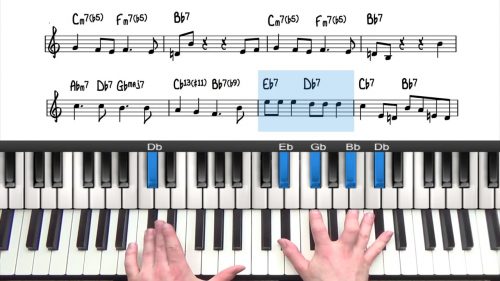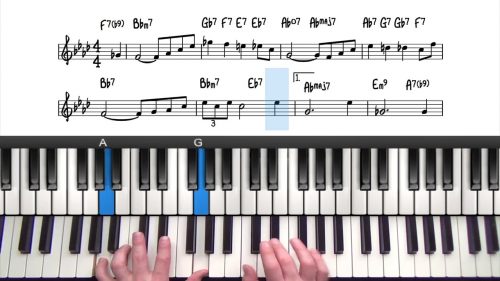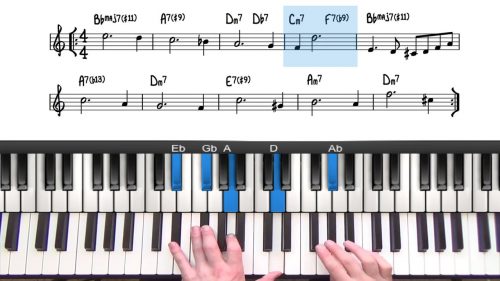Blue Moon Piano Tutorial
Welcome to this tutorial on the famous jazz ballad “Blue Moon” by Richard Rodgers.
We start this lesson by discussing the form and highlighting the repeated 1625 progression throughout the chord changes.
We play through with some simple voicings and then talk about how we can enhance the repetitive chord sequence with chord substitutions and reharmonisations.
Part 2 – Intro & Outro
In part 2 of the lesson we explore the theory behind the intro and ending of the arrangement. Both the intro and the ending are derived from the 1625 progression
Practice Tips
-
In creating this arrangement, we drew inspiration from the introduction on the Kenny Barron recording of this tune, check it out here.
-
Remember that listening is an essential component of your jazz piano study.
-
You can't play this music with conviction, unless you have spent the time to listen!
-
Visit the Forum/Community area to share and discover your favourite records.







Hiya Heyden,
Wow, now this is a beautiful lesson from a didactic perspective; you give a great round up or inventory if not only the chords but also the extensions/alternatives etc. This makes it a hell of a lot easier for guys like myself to prepare for the lesson. As opposed to following the commentary and stoppoing each time to see how each chord is voiced etc etc.
Brilliant, nice piece of work man..my compliments
Regards
Bill K
Hi Heyden,
Requesting clarification, re. terminology — you mention early in the tutorial (starting at 04:09) that in the 1-6-2-5 chord progression, and I quote “…instead of playing the 2 chord as a minor chord, we usually play it as a dominant chord.”
However here you’re referring to the C7, which is the 6 (VI) chord — not the 2 chord. Yes?
Hi Robert,
Thanks for letting me know about this and yes you are correct that I am referring to the VI chord – the C7 – and I get mixed up and refer to this as the ii chord. Apologies for the confusion here. I will download the video and see if I can fix the narration.
It’s worth noting, that when playing progressions such as 251, 1625, and 36251, we can often play the ii-7 chord as a dominant chord. The main thing to pay attention to is the melody note, for example in the 2nd bar of the A section we have a F-7 chord with the note Ab in the melody which is the minor 3rd of F-7. In this case I would probably favor the regular minor 7 chord, but an F7#5#9 chord would also work, with the note Ab then becoming the #9 of F7.
Moving onto bars 4 and 6, we have the notes F and Eb respectively over the F-7 chords. Try turning the F-7 chord into a dominant chord (F13 works nicely in bar 4) and you will see that it sounds subtly different to F-7 which can be a nice effect in repetitive tunes such as this one.
In the final bar of the A Section, there is space in the melody and so we have complete freedom to play the ii and VI chords as minor or as dominant chords.
I hope that helps Robert and thanks again for flagging the ‘narration typo’ – I will get that fixed.
Talk soon,
Hayden